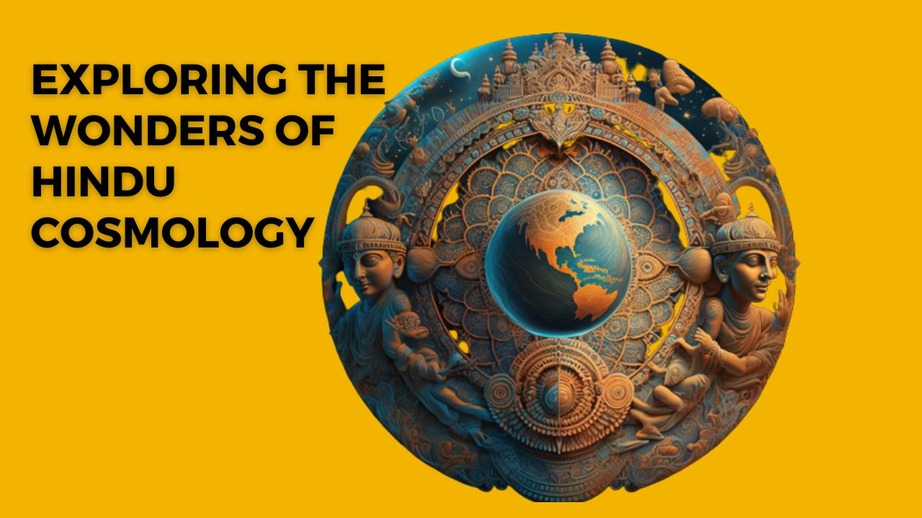Welcome to our journey through the mystical realms of Hinduism, where ancient beliefs interweave seamlessly with the cosmic tapestry. In this series, we will explore celestial gods in Hinduism, beginning with an introduction to Hindu cosmology.
Hindu Cosmology: The Universe of Myths and Stars
Imagine a universe where gods reside in the heavens, where the Sun, Moon, and stars are not just celestial bodies but divine beings with distinct personalities and powers. This is the essence of Hindu cosmology, a unique worldview that transcends scientific understanding to embrace the mystical and the sacred.
In Hinduism, the universe is not merely a physical realm governed by natural laws but a rich tapestry of myths, legends, and celestial wonders.
Here, gods and goddesses preside over various realms, each with significance and purpose. These celestial beings are not distant entities but integral parts of the cosmos, shaping the universe’s destiny and its inhabitants.
The Sun, known as Surya, is not just a blazing ball of fire in the sky but a radiant deity symbolizing life, energy, and enlightenment.
The Moon, personified as Chandra, governs the ebb and flow of time, casting its soothing light over the night. These celestial bodies are not passive observers but active participants in the grand cosmic drama.
As we delve deeper into this enchanting realm, we’ll discover how Hindu cosmology influences everything from ancient temple architecture to modern-day astrology. Join us as we unravel the celestial mysteries of Hinduism, one divine story at a time.
Unveiling the Radiant Deity: Surya, the Sun God
Our journey through Hindu cosmology begins with a closer look at Surya, the resplendent Sun god. In Hinduism, Surya is not only a celestial body but a divine entity whose radiance and power illuminate both the physical and spiritual realms.
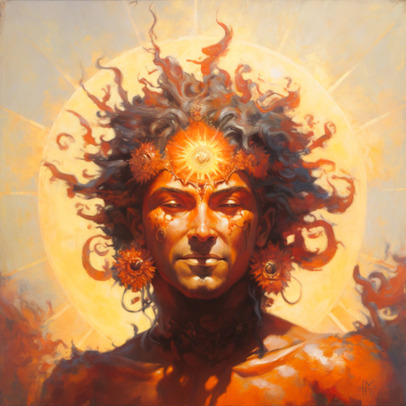
Surya: The Life-Giver and Source of Light
Imagine the Sun as more than just a ball of fire in the sky; envision it as the life-giver, the source of vitality. Surya, often depicted with a golden chariot drawn by seven horses, symbolizes the dawn of creation. As the god of light and illumination, he dispels darkness, both in the external world and within the human soul.
Surya’s significance extends beyond the physical world. In Hindu mythology, he is revered as the father of the legendary hero Hanuman and as an essential deity in the practice of Surya Namaskar, a yogic sequence dedicated to the Sun. The Sun’s journey across the sky represents the cycle of birth, life, death, and rebirth, echoing the eternal cosmic dance.
Surya in Iconography and Rituals
Exploring Surya’s iconography reveals profound symbolism. He is often depicted with four arms, holding a lotus, a conch shell, a chakra (discus), and a mace, symbolizing purity, sound, time, and strength, respectively. These attributes underscore his multifaceted role in Hindu cosmology.
Surya’s annual journey through the zodiac, known as the Surya Siddhanta, significantly influences Hindu calendars and festivals. It determines auspicious times for ceremonies and rituals, highlighting the deep connection between the celestial and earthly realms.
As we continue our celestial voyage through Hinduism, we’ll delve into more gods, each with their own unique role in this intricate cosmic drama. Join us next time as we explore Chandra, the Moon god, and discover the celestial magic he weaves into Hindu mythology and culture.
Chandra: Illuminating the Mysteries of the Moon God
In the second chapter of our exploration into celestial gods in Hinduism, we turn our gaze towards Chandra, the Moon god. Like Surya, Chandra holds a pivotal place in Hindu cosmology and mythology, revealing a different facet of the cosmic tapestry.
Chandra: The Luminous Lunar Deity
The Moon, as personified by Chandra, is not just a silvery disc in the night sky; it is a luminary with a compelling story. Chandra is depicted as a fair and handsome deity, often seen holding a lotus or riding a chariot drawn by white horses. His calm, soothing light is seen as a reflection of his tranquil and serene nature.
Chandra’s role in Hinduism goes beyond mere aesthetics. The waxing and waning of the Moon’s phases reflect the cyclical nature of life, death, and rebirth, which are central themes in Hindu philosophy. In this way, Chandra serves as a reminder of the eternal cosmic order, where nothing indeed perishes but instead undergoes transformation.

The Moon’s Influence on Hindu Rituals and Festivals
Chandra’s presence is deeply embedded in Hindu rituals and festivals. Karva Chauth, a famous North Indian festival, sees married women fasting from sunrise until they see the Moon, praying for their husband’s well-being and longevity. This festival beautifully encapsulates the connection between Chandra, marital bliss, and family harmony.
In Vedic astrology, the Moon plays a pivotal role in determining one’s emotional and psychological disposition. The position of the Moon at the time of one’s birth is believed to influence personality traits, and it’s a critical factor in the creation of one’s birth chart.
Chandra’s Radiant Legacy
Chandra, the Moon god, with his silvery glow, symbolizes the gentle and nurturing aspects of the cosmos. His tranquil presence in the night sky has inspired poets, artists, and philosophers for millennia, and his role in Hindu cosmology continues to influence both spiritual and practical aspects of daily life.
As we continue our celestial journey through Hinduism, we will delve deeper into the cosmic dance of Lord Shiva, the alignment of heavenly bodies in ancient temples, and the influence of celestial gods on astrology and philosophy. Stay tuned for more revelations from the enchanting world of Hindu celestial deities.
Nataraja: Lord of the Dance
Nataraja, often depicted as Lord Shiva in his dancing form, embodies the divine artistry of the cosmos. He is the ultimate performer, and his dance, called the Tandava, symbolizes the eternal rhythm of the universe.
His dynamic dance represents the simultaneous creation and destruction that sustain the Cosmos.
In this captivating portrayal, Shiva is shown with multiple arms, each holding symbolic items.
His raised right hand signifies the “Abhaya Mudra,” which reassures the devotee, while the left-hand points to his raised left foot, meaning liberation from worldly attachments. The fiery circle of flames around him represents the cycle of creation and destruction, and his right foot crushes the demon Apasmara, symbolizing ignorance.
Nataraja’s Cosmic Significance
Nataraja’s dance is not just a captivating artistic representation; it’s a profound philosophical concept. It encapsulates the idea that the universe is in a constant state of flux, where everything is born, exists, and ultimately dissolves back into the cosmic dance.
Shiva’s dance also reflects the interconnectedness of all things. Just as the dance cannot exist without the dancer, the cosmos cannot exist without the divine force. This profound concept has inspired poets, scholars, and seekers of truth for centuries.
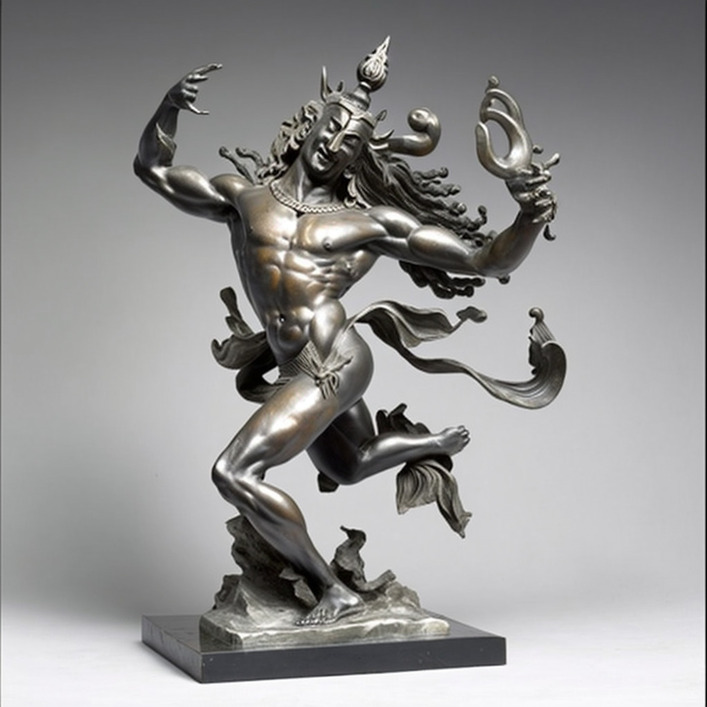
The Cosmic Dance in Modern Science
Interestingly, Nataraja’s dance also finds echoes in modern physics, where the universe is seen as a dance of particles, waves, and forces. The interconnectedness and rhythmic patterns of the cosmos bear a striking resemblance to the ancient symbolism of Nataraja’s Tandava.
Our exploration of celestial gods in Hinduism takes a turn toward the heavens with the introduction of the Navagrahas, a group of nine planetary deities. These divine beings are believed to influence human lives based on the principles of Vedic astrology, adding depth to the intricate tapestry of Hindu cosmology.
Navagrahas: The Nine Celestial Guardians
In Hindu cosmology, the Navagrahas are considered the celestial guardians who govern the movements and influences of the planets in our solar system. Each deity represents a specific planet and holds sway over particular aspects of life, fate, and karma. Understanding the Navagrahas is essential for believers seeking insight into their destinies.
The Navagrahas consist of the following deities:
- Surya (Sun)
- Chandra (Moon)
- Mangal (Mars)
- Budha (Mercury)
- Guru (Jupiter)
- Shukra (Venus)
- Shani (Saturn)
- Rahu (North Node of the Moon)
- Ketu (South Node of the Moon)
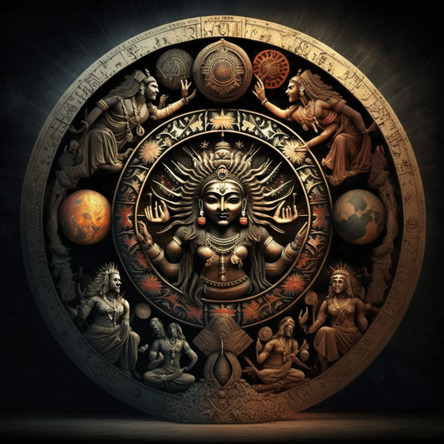
Influence on Human Lives
In Vedic astrology, one’s birth chart, or horoscope, is created by mapping the positions of the Navagrahas at the time of birth. The alignment of these celestial bodies is believed to influence a person’s character, life events, and karmic path.
For instance, Surya (Sun) is associated with leadership and vitality, while Shukra (Venus) is linked to love and beauty. Rahu and Ketu, being shadow planets, represent karmic forces that shape a person’s destiny. Astrologers analyze these planetary positions to provide guidance on various life matters, including career, relationships, and health.
Rituals and Remedies
Individuals often perform rituals and remedies dedicated to specific Navagrahas to mitigate adverse planetary influences or enhance positive ones. These may include prayers, offerings, wearing gemstones, or visiting temples dedicated to these celestial guardians.
The Navagrahas play a vital role in Hindu rituals and festivals, emphasizing the connection between celestial forces and earthly life. Understanding their influence adds depth to one’s spiritual journey and helps believers navigate life’s challenges and opportunities.
Temples as Cosmic Maps
Step into an ancient Hindu temple, and you’ll find more than just ornate sculptures and divine idols. You’ll encounter a precise alignment with the movements of celestial bodies. These temples are designed to symbolize the macrocosm (the universe) and the microcosm (the individual).
The temple’s main deity resides in the inner sanctum, and its placement is meticulously calculated to align with celestial events. For example, during specific festivals, the rays of the rising or setting Sun may directly illuminate the temple deity, creating a breathtaking spectacle that symbolizes the divine connection between heaven and earth.
The Cosmic Dance of Light and Shadow
One of the most remarkable astronomical phenomena found in some Hindu temples is the play of light and shadow. Carved with precision, the temple structures cast intricate patterns of sunlight and shadow during specific times of the year. These patterns often align with significant celestial events like solstices and equinoxes.
For instance, the Sun Temple at Konark, Odisha, is designed in the shape of a colossal chariot with 12 pairs of intricately carved wheels representing the months and seven horses representing the days of the week. The temple’s wheels cast unique shadows, which accurately mark the time of the day.
Temple Geometry and Sacred Geometry
The Hindu temple architecture is also steeped in sacred geometry. The dimensions, proportions, and placement of temple structures adhere to mathematical principles believed to have cosmic significance. Mandalas, yantras, and other geometric patterns are incorporated into temple design, reflecting the harmony and order of the universe.
Understanding the celestial alignments and sacred geometry of Hindu temples provides a deeper appreciation of their spiritual and cultural significance. These temples serve as living testimonies to the profound connection between the celestial and the earthly, reminding us of the ancient wisdom that sought to bridge the gap between the human soul and the cosmos.
The Celestial Influence on Hindu Calendars and Festivals
In this section, we gaze at the intricate relationship between heavenly bodies and the Hindu calendar system. The heavens not only inspire awe but also guide the timing of festivals, rituals, and daily life in Hindu culture.
The Lunar and Solar Calendars
Hinduism employs two primary calendar systems: the lunar calendar (tithi) and the solar calendar (solar month). These calendars are inextricably linked to the movements of the Moon and the Sun, reflecting the importance of celestial bodies in everyday life.
The lunar calendar, based on the phases of the Moon, governs the timing of many Hindu festivals. Each month, or “masa,” begins with the new Moon and is divided into “tithis,” or lunar days. Festivals like Diwali and Holi, as well as auspicious occasions like weddings and naming ceremonies, are often determined by lunar dates.
The solar calendar, on the other hand, is based on the position of the Sun and divides the year into twelve solar months. Major Hindu festivals, such as Makar Sankranti, which marks the Sun’s transition into the zodiac sign of Capricorn, follow the solar calendar.
Festivals Aligned with Celestial Events
Many Hindu festivals are intricately connected to specific celestial events. For instance, Mahashivaratri, dedicated to Lord Shiva, falls on the 14th day of the waning Moon in the month of Phalguna (February-March). Devotees stay awake all night, engaging in worship and meditation, aligning with the energy of the cosmos during this lunar phase.
Navaratri, a festival devoted to the goddess Durga, lasts for nine nights and coincides with the autumnal equinox when day and night are of equal length. This celestial alignment emphasizes the balance between light and dark, good and evil.
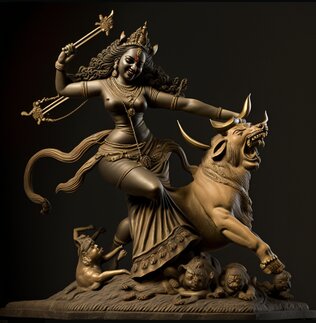
Astronomical Insights into Festivals
Modern astronomy provides intriguing insights into the timing of Hindu festivals. Understanding celestial phenomena, such as equinoxes and solstices, can shed light on the symbolism and significance of these ancient traditions. For instance, the celebration of Makar Sankranti aligns with the Sun’s entry into the northern hemisphere, symbolizing the return of warmth and light after the winter solstice.
Hindu calendars and festivals are not just about marking time; they are a profound expression of the cosmic order and the deep spiritual connection between humans and the celestial realms.
The Divine Chariots of Hinduism: Celestial Vehicles of Deities
In this segment of our stellar exploration of Hinduism, we delve into the intriguing concept of the celestial vehicles associated with various deities. These divine chariots, often overlooked, are fascinating elements of Hindu cosmology that hold symbolic and practical significance.
Garuda: The Mighty Eagle of Lord Vishnu
One of the most renowned celestial vehicles in Hindu mythology is Garuda, the great eagle and mount of Lord Vishnu. Garuda is depicted as a colossal bird with immense wings, symbolizing power and speed. He is revered for his unwavering devotion to Lord Vishnu.
The imagery of Vishnu riding Garuda signifies the divine’s dominion over the skies and the earth. Garuda’s role extends beyond being a mode of transport; he is an embodiment of dharma (righteousness) and represents the triumph of good over evil. His battle with the serpent demon, Nagas, is a recurring theme in Hindu mythology, underscoring the eternal struggle between order and chaos.

Nandi: The Loyal Bull of Lord Shiva
In contrast to the majestic Garuda, Nandi serves as the celestial vehicle of Lord Shiva. Nandi is depicted as a massive white bull, representing strength, purity, and patience. His unwavering loyalty to Lord Shiva is a symbol of devotion and the pursuit of spiritual knowledge.
Nandi’s presence in front of Shiva temples not only honors the deity but also invites seekers to emulate his qualities of devotion and humility. It serves as a reminder that the path to spiritual enlightenment often involves taming the bull-like mind and desires.
Hamsa: The Graceful Swan of Goddess Saraswati
Goddess Saraswati, the patroness of knowledge, arts, and learning, is often associated with the celestial vehicle Hamsa, a graceful swan. Hamsa embodies purity, discrimination, and the ability to discern between right and wrong. It signifies the journey from ignorance to enlightenment through the pursuit of knowledge.
Saraswati riding Hamsa represents the union of wisdom and intuition, reminding us that actual knowledge transcends mere facts and requires the guidance of inner discernment.
Peacock: The Vehicle of Lord Murugan
Lord Murugan, also known as Kartikeya or Skanda, uses a peacock as his celestial vehicle. The peacock represents grace, beauty, and splendor, and its association with Murugan reflects the deity’s valor and combat skills.
The symbolism extends to Murugan’s role as the commander of the celestial army, leading the battle against evil forces. The peacock’s ability to dance and display its vibrant feathers serves as a metaphor for the triumph of spiritual beauty over ego and arrogance.
The celestial vehicles of Hindu deities are more than mythological companions; they carry profound symbolic meanings that teach valuable life lessons. These divine chariots symbolize devotion, strength, wisdom, and grace, offering spiritual guidance as we navigate the cosmic journey of life.
As our exploration of celestial gods in Hinduism continues, we will explore more aspects of this rich cosmology, including the influence of heavenly bodies on Hindu rituals, philosophy, and modern science. Join us next time as we uncover further celestial wonders within the Hindu tradition.
The Cosmic Connection: Hinduism, Astronomy, and Modern Science
Ancient Wisdom in Modern Context
Hinduism’s profound connection with celestial deities and cosmic events is not confined to ancient texts and rituals. It also serves as a source of inspiration for scientific inquiry and understanding of the universe.
For instance, the reverence for the Sun as a divine source of energy and life aligns with our contemporary understanding of the Sun as a star, a powerful nuclear fusion reactor sustaining our solar system.
Similarly, the recognition of Moon phases and their influence on human behavior and agriculture finds resonance in fields like chronobiology, which studies the biological rhythms of living organisms in relation to celestial cycles.
Modern Astronomy and Hindu Cosmology
Modern astronomy, with its advanced telescopes and space exploration, provides insights into the workings of the cosmos that parallel Hindu cosmological concepts. The discovery of exoplanets, black holes, and the intricate dance of galaxies reinforces the idea of an ever-expanding and interconnected universe akin to the eternal cosmic dance of Lord Shiva.
Furthermore, the concept of time in Hindu cosmology, with its vast cycles of creation and dissolution, aligns with contemporary theories in cosmology and the vision of a cyclical universe. Modern physics explores the idea of a multiverse, where universes come into existence, expand, contract, and perhaps give rise to new universes—a notion that echoes Hindu beliefs in the eternal cosmic cycle.
Celestial Gods and Cultural Influence
Hinduism’s celestial gods and their significance continue to influence various aspects of modern Indian culture, from astrology and architecture to festivals and rituals. Many contemporary Indians maintain a deep reverence for these celestial beings and incorporate their teachings into their daily lives.
Moreover, the study of Hindu cosmology and mythology serves as a bridge between the scientific and spiritual realms, fostering a sense of wonder and interconnectedness with the universe. It exemplifies how ancient wisdom can complement and enrich our understanding of the natural world.
Celestial Gods: Guardians of Life and Soul in Daily Hinduism
In the final stretch of our exploration of celestial gods in Hinduism, we arrive at a crucial juncture where the influence of these divine beings permeates the daily lives of practitioners, offering guidance, protection, and spiritual connection.
Astrology: Celestial Maps of Destiny
Astrology, known as “Jyotish” in Sanskrit, plays a significant role in many Hindus’ lives. It is the study of celestial positions and their influence on human affairs and natural phenomena. Hindu astrology incorporates the Navagrahas—the nine planetary deities—as key players in shaping an individual’s destiny.
People consult astrologers to create their birth charts, which map the positions of the Navagrahas at the time of their birth. These charts provide insights into various aspects of life, including career, relationships, and health. By aligning their actions with astrological guidance, individuals seek to mitigate negative influences and enhance positive ones.
Naming Conventions: Seeking Celestial Favor
Naming a child in Hinduism is a sacred act with profound cosmic implications. Many names are derived from the deities and celestial bodies.
For example, names like Surya, Chandra, and Mangal are associated with the Sun, Moon, and Mars, respectively. Choosing such names is believed to invoke the blessings and protection of these celestial entities.
Rituals and Offerings: Connecting with the Divine
Hindu rituals and daily puja (worship) often involve offerings to celestial deities. Devotees light lamps to symbolize the Sun’s radiance (Surya), pour milk on Shiva’s linga to cool his fiery energy and offer fragrant flowers to deities associated with celestial bodies.
These rituals are not mere acts of devotion; they are also a way to harmonize with the celestial forces believed to guide and influence life’s journey. Observing these customs is a means of seeking angelic blessings and aligning with the cosmic order.
Philosophical Reflections: The Cosmic Connection
Hindu philosophy, especially Advaita Vedanta and Samkhya, underscores the interconnectedness of the individual soul (Atman) with the universal soul (Brahman) and the cosmos. It explores the idea that the divine resides within each being, connecting human consciousness with the celestial realms.
The celestial gods symbolize aspects of this cosmic consciousness, guiding individuals on their spiritual journeys. By contemplating these deities, practitioners seek to realize their own divine nature and transcend the limitations of the material world.
In our exploration of celestial gods in Hinduism, we’ve uncovered a rich tapestry of beliefs and practices that bridge the gap between the earthly and the divine. These deities offer inspiration, guidance, and a profound connection to the cosmos in the everyday lives of millions.
As we conclude our journey, we leave with a deeper appreciation for the enduring influence of Hindu cosmology and its celestial gods on culture, spirituality, and the human soul.
Solar Deities: Light and Life-Givers
The concept of solar deities, gods associated with the Sun, is not unique to Hinduism. In ancient Egyptian mythology, Ra was the Sun god, symbolizing light, warmth, and life. Similarly, in Greek mythology, Apollo was the radiant god of the Sun, poetry, and music.
These deities, like Surya in Hinduism, represent the life-giving force of the Sun and the spiritual significance of light. They connect the physical world to the celestial realms and embody the divine attributes of illumination and vitality.
Lunar Deities: Cycles of Renewal
The Moon, revered as Chandra in Hinduism, also appears prominently in other mythologies. In Greek mythology, Artemis was the goddess of the Moon, the hunt, and wilderness. She embodied the Moon’s connection to cycles, change, and the mystical aspects of the night.
The lunar deities in various cultures symbolize the cyclic nature of existence, the ebb and flow of emotions, and the mysteries of the night. They inspire awe and contemplation of the cosmos’ enduring rhythms.
Planetary Deities: Celestial Guardians
The Navagrahas, or planetary deities in Hinduism, have counterparts in other belief systems. In Roman mythology, planets were associated with deities like Mars (war), Venus (love), and Jupiter (king of the gods). In Norse mythology, celestial bodies like the Sun and Moon were personified as Sól and Máni.
These celestial beings, whether planets or heavenly bodies, often embodied specific traits and influences, mirroring the Hindu concept of the Navagrahas governing various aspects of life.
Common Threads of Cosmic Reverence
The similarities in portraying celestial gods across cultures highlight humanity’s shared fascination with the heavens and its quest for spiritual understanding. These myths and deities testify to our intrinsic connection to the cosmos and our desire to make sense of the celestial wonders that grace our skies.

